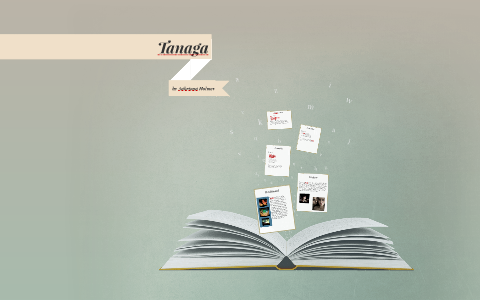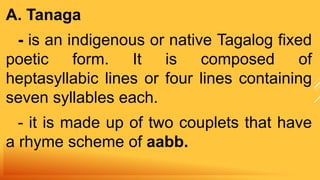According to Denis M. Traditional Japanese tanka poems consist of 31 syllables written in a single unbroken line.
Secondly what is the mean of haiku.

Tanaga writing rules. The first difference between haiku and tanka is syllable. In other words there are 5 syllables in line 1 7 syllables in line 2 5 syllables in line 3 and 7 syllables in lines 4 and 5. I suspect most of us know this as part of our English oral tradition.
History of the Tanka Form. Taylor was likely not trying to write a tanaga but the form of her poem matches the tanaga form. Secondly haiku must contain seasonal words Kigo and the image and emotion of each seasonal.
Tanka The tanka is a thirty-one-syllable poem traditionally written in a single unbroken line. Rhymed originally aaaa bbbb cccc etc modern Tanagas also use aabb ccdd etc or abba cddc etc or any combination rhyme can be used. Stanzaic written in any number of quatrains.
These poems are made up of five units which after translation into English usually take the form of five lines. Garrison one should not adhere to a strict formula. It is usually written about nature.
AcoI momonting lomot sa iyoI popolopot Modern orthography Katitibay kang tulos Sakaling datnan ng agos. A tanaga consists of four lines with seven syllables each with a rhyme at ending each line. In tanka 5-7-5 is called Kamino-ku upper phrase and 7-7 is called Shimono-ku lower phrase.
Tanaga is a poem composed of four lines with each line having seven syllables written in aaaa or aabb abba or abab rhyming pattern. The lines must follow the 5-7-5-7-7 format. Aug 16 2021 5 min read.
The first line is 5 syllables. A form of waka Japanese song or verse tanka translates as short song and is better known in its five-line 57577 syllable count form. If you have ever written a haiku you will notice that tanka is kind of like a longer version of haiku that gives you a little more room to tell a story.
Authors note-A Tanaga is a Filipino form of poetry from the 16th century. Neither does it require a period at the end. Pitong Pantig Pintig at Pagitan an anthology of 50 tanaga in Filipino and Bikolnon languages was virtually launched on Friday during which NCCA National Committee on Language and Translation Chair Dr.
While some writers follow this pattern others use a pattern of 5 lines of 31 syllables or less with lines that are shortlongshortlonglong. They are free verse so they do not have to rhyme but must follow specific syllable patterns. Punctuation and capitalization are up to the poet and need not follow the rigid rules used in structuring sentences.
Tanka are basically fragments and phrases that requires little to no punctuation. Tanka does not require each line to start with a capital. Twinkle twinkle little star.
To gain a richer understanding of this ancient art form and even try your hand at writing a few read more about its deep history and origins below. All other lines must have 7 syllables. This form was found at Kaleidoscope.
Haiku is composed of three phrases 5-7-5 and tanka is of five phrases 5-7-5-7-7. Pick an animal or plant in nature that you find inspiring. Midway through a tanka poem theres a change in perception.
When writing tanka in English just as when writing haiku in English you can substitute syllables for kana. The modern form is composed of four-line stanzas of seven syllables each with end rhymes normally AABB but this can. Keeping this in consideration what is the structure of tanaga.
Here are some examples using the rhyme scheme AABB. A haiku does not have to rhyme in fact usually it does not rhyme at all. Diona is a pre-Hispanic rhyming poem of three lines with seven syllables in each line expressing a complete thought.
It can include the repetition of words or sounds. The basic structure of a tanka poem is 5 7 5 7 7. Or that all it takes to make one is to hit a certain syllable count.
How I wonder what you are. Poetry during the pandemic has taken the form of tanaga a native Filipino poem with 4 lines and 7 syllables each. A tanka usually expresses a mood thought or feeling.
As you study tanka poetry youll notice it bears a resemblance to sonnets. The Tanaga consists of four lines with seven syllables each with the same rhyme at the end of each line --- that is to say a 7-7-7-7 Syllabic verse with an AABB rhyme scheme. In English translations the tanka tends to take on a five-line form which brings us to this important note.
In the Tagalog original using archaic orthography. The third line is 5 syllables like the first. You can also look at nature images online to get ideas for the poem.
Below is an example of a tanaga. The first third lines must have 5 syllables. The second line is 7 syllables.
Its touch is poisonous to writing poetry. A tanka poem is an important form in Japanese poetry that follows a syllable pattern of 5-7-5-7-7. Sana ay wag ma galit.
Tanaga have no titles. Composed with the liberal use of metaphor. Written by the MasterClass staff.
Archaic orthography Catitibay ca tolos sacaling datnang agos. A tanka does not have to rhyme. Heres an example of an English poem written by Jane Taylor and published in Rhymes for the Nursery in 1806.
However this varies depending on the rhyme schemes. The traditional tanka pattern is 57577 kana per line. A tanka must be exactly 5 lines.
But this is not necessary. Tanka poems which originated in Japan are short poems intended to evoke vivid imagery and reflection for the reader. Syllabic 7-7-7-7 syllables per line.
Coroza sang some of. Writing haiku might seem simple. They follow a syllable pattern of 5-7-5-7-7 similar and yet longer than a haiku.
__NoTOC__ The Tanaga is a type of Filipino poem consisting of four lines with seven syllables each with the same rhyme at the end of each line --- that is to say a 7-7-7-7 Syllabic verse with an AABB rhyme scheme as in this example. 1 To get inspiration for the poem you can also go for a walk outside in a natural area like a park or a garden.



Komentar